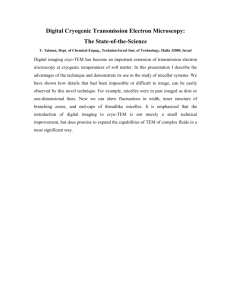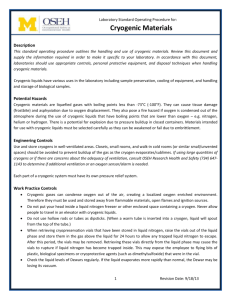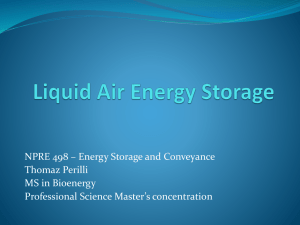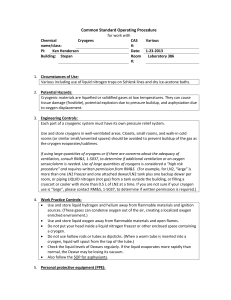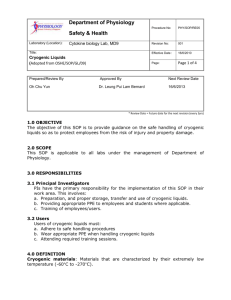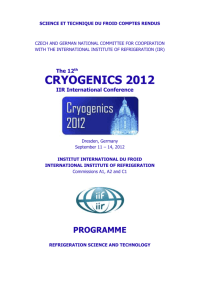Cryogenic Safety Procedures
advertisement
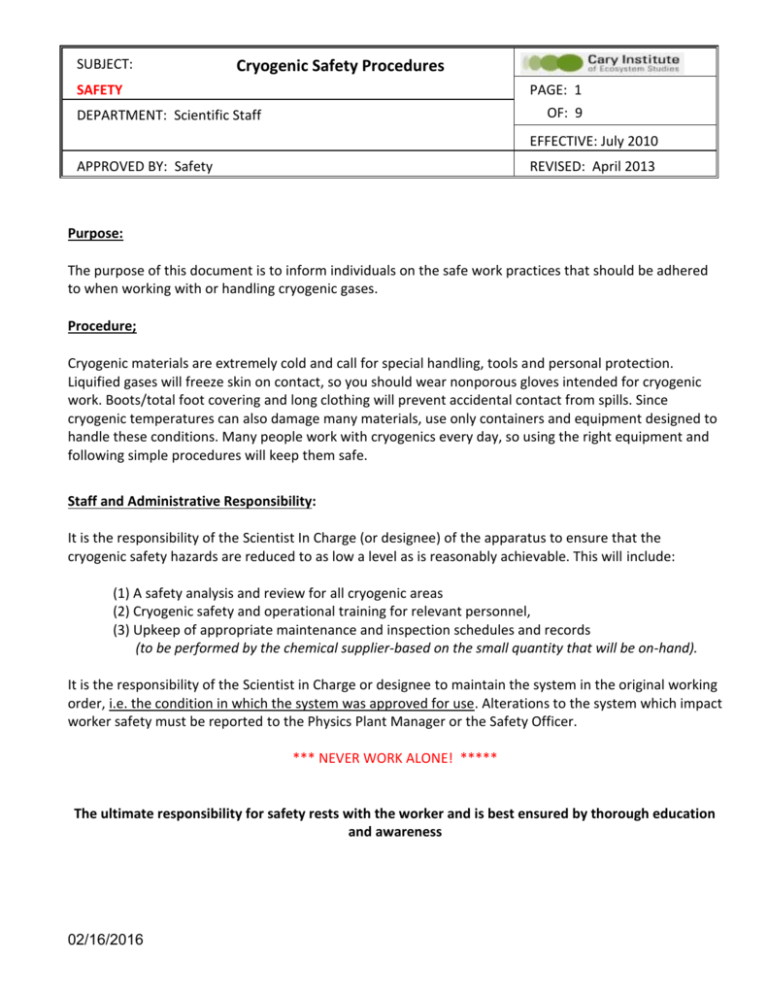
SUBJECT: Cryogenic Safety Procedures SAFETY PAGE: 1 OF: 9 DEPARTMENT: Scientific Staff EFFECTIVE: July 2010 APPROVED BY: Safety REVISED: April 2013 Purpose: The purpose of this document is to inform individuals on the safe work practices that should be adhered to when working with or handling cryogenic gases. Procedure; Cryogenic materials are extremely cold and call for special handling, tools and personal protection. Liquified gases will freeze skin on contact, so you should wear nonporous gloves intended for cryogenic work. Boots/total foot covering and long clothing will prevent accidental contact from spills. Since cryogenic temperatures can also damage many materials, use only containers and equipment designed to handle these conditions. Many people work with cryogenics every day, so using the right equipment and following simple procedures will keep them safe. Staff and Administrative Responsibility: It is the responsibility of the Scientist In Charge (or designee) of the apparatus to ensure that the cryogenic safety hazards are reduced to as low a level as is reasonably achievable. This will include: (1) A safety analysis and review for all cryogenic areas (2) Cryogenic safety and operational training for relevant personnel, (3) Upkeep of appropriate maintenance and inspection schedules and records (to be performed by the chemical supplier-based on the small quantity that will be on-hand). It is the responsibility of the Scientist in Charge or designee to maintain the system in the original working order, i.e. the condition in which the system was approved for use. Alterations to the system which impact worker safety must be reported to the Physics Plant Manager or the Safety Officer. *** NEVER WORK ALONE! ***** The ultimate responsibility for safety rests with the worker and is best ensured by thorough education and awareness 02/16/2016 SUBJECT: Cryogenic Safety Procedures SAFETY DEPARTMENT: Scientific Staff PAGE: 2 OF: 9 EFFECTIVE: July 2010 APPROVED BY: Safety REVISED: April 2013 Primary Hazards Cryogenic materials have temperatures roughly lower than -150C. This will instantly cause frostbite or burn any exposed skin. Prolonged contact will cause serious, possibly life-threatening injury. Because of this hazard, avoid any direct contact with cryogenic solids or liquids to your skin or eyes. Very low temperatures cause normally soft, flexible objects such as hoses, gaskets and seals to become brittle and crack. Cracked parts may have sharp edges, posing a laceration hazard. Store cryogenic materials only in containers specifically designed for the purpose. Certain closed-cell plastic foams, such as styrofoam, can contain liquid nitrogen for short periods of time. Metals will undergo thermal contraction and possibly crack. They will also become extremely cold to the touch. The safety hazards associated with the use of cryogenic liquids can be categorized as follows: A. Cold contact burns Liquid or low-temperature gas from any of the specified cryogenic substances will produce effects on the skin similar to a burn. B. Asphyxiation Degrees of asphyxia will occur when the oxygen content of the working environment is less than 20.9% by volume. Effects from oxygen deficiency become noticeable at levels below ~18% and sudden death may occur at ~6% oxygen content by volume. This decrease in oxygen content can be caused by a failure/leak of the cryogenic vessel or transfer line and subsequent vaporization of the cryogen. C. Explosion - Pressure Heat flux into the cryogen from the environment will vaporize the liquid and potentially cause pressure buildup in cryogenic containment vessels and transfer lines. Adequate pressure relief must be provided to all parts of a system to permit this routine outgassing and prevent explosion. D. Explosion - Chemical Cryogenic fluids with a boiling point below that of liquid oxygen are able to condense oxygen from the atmosphere. Repeated replenishment of the system can thereby cause oxygen to accumulate as an unwanted contaminant. Similar oxygen enrichment may occur where condensed air accumulates on the exterior of cryogenic piping. Violent reactions, e.g. rapid combustion or explosion, may occur if the materials which make contact with the oxygen are combustible. 02/16/2016 SUBJECT: Cryogenic Safety Procedures SAFETY PAGE: 3 OF: 9 DEPARTMENT: Scientific Staff EFFECTIVE: July 2010 APPROVED BY: Safety REVISED: April 2013 Secondary Hazards Cryogenic liquids boil at room temperature, giving off gases. These gases will be extremely cold. While the cooling power of a gas is less than a liquid's, you should still keep it at a safe distance. Never store cryogenic liquids in a sealed container without pressure relief. As the liquids turn to gas, pressure will build past the container's bursting point, possibly resulting in an explosion. First Aid Measures EYES: Never introduce ointment or oil into the eyes without medical advice! In case of freezing or cryogenic "burns" caused by rapidly evaporating liquid, DO NOT WASH THE EYES WITH HOT OR EVEN TEPID WATER! Remove victim from the source of contamination. For contact with small amounts of liquid, open the eyelids wide to allow the liquid to evaporate. For contact with large amounts, rinse with a low pressure stream of cool water for 15 minutes. Refer the victim to an ophthalmologist for treatment and follow up. If the victim cannot tolerate light, protect the eyes with dark glasses. The use of bandages is not recommended as keeping the eyelids closed or exerting pressure on the eyelid may cause further damage. SKIN: For dermal contact or frostbite: Remove contaminated clothing and flush affected areas with lukewarm water. DO NOT USE HOT WATER. A physician should see the patient promptly if contact with the product has resulted in blistering of the dermal surface or in deep tissue freezing. INGESTION: A physician should see the patient promptly if the cryogenic "burn" has resulted in blistering of the dermal surface or deep tissue freezing. INHALATION: PROMPT MEDICAL ATTENTION IS MANDATORY IN ALL CASES OF OVEREXPOSURE. Victims should be assisted to an uncontaminated area and inhale fresh air. Quick removal from the contaminated area is most important. Unconscious persons should be moved to an uncontaminated area, and if breathing has stopped, administer artificial resuscitation and supplemental oxygen. Seek professional medical attention. 02/16/2016 SUBJECT: Cryogenic Safety Procedures SAFETY DEPARTMENT: Scientific Staff PAGE: 4 OF: 9 EFFECTIVE: July 2010 APPROVED BY: Safety REVISED: April 2013 Personal Protective Equipment Whenever handling or transfer of cryogenic fluids might result in exposure to the cold liquid, boil-off gas, or surface, protective clothing shall be worn. This will include: REMOVAL OF ALL JEWLERY, WATCHES, ETC. FROM HANDS, ARMS AND FINGERS Face Shield and/or Safety Goggles Safety Gloves Long-sleeved shirts, pants and/or Lab Coats Eye protection is required at all times when working with cryogenic fluids. When pouring a cryogen, working with a wide mouth dewar or around the exhaust of cold boil-off gas, use of a full face shield is recommended. Hand protection is required to guard against the hazard of touching cold surfaces. Loose insulating gloves can be used. NEVER WORK ALONE Use For general use, dispense cryogenic liquids from the vendor supplied small dewars, into the Styrofoam container located in the lab hood. After filling the Styrofoam container, specimens will immediately be dipped into the Styrofoam container and froze using gloves and/or tongs as needed. Frozen biological specimens, will then be stored in freezer until further use. Maintenance and Inspection Cryogenic systems and equipment will be inspected and maintained on a regular basis by the vendor supplying the fluid. Training of Cryogenic Personnel All personnel working with cryogenic fluids must be thoroughly familiar with the hazards involved. They must also be familiar with all emergency measures that might be required in the event of an accident. Employees who have not worked with cryogenic fluids and systems must be trained on the job by experienced employees until thoroughly familiar with safe methods of operation. 02/16/2016 SUBJECT: Cryogenic Safety Procedures SAFETY DEPARTMENT: Scientific Staff PAGE: 5 OF: 9 EFFECTIVE: July 2010 APPROVED BY: Safety REVISED: April 2013 The training will address: The physical, chemical and physiological hazards associated with cryogenic fluids The proper handling procedures for cryogens and cryogenic containers Description of the equipment Operating procedures Maintenance schedule and procedures Additionally, each employee will receive training by the responsible scientist on the specific cryogenic equipment or system he is expected to use. Handling Emergencies Spills Involving Cryogens Spill equipment is located at the end of the hall in the Likens Lab and near the Hazardous Waste room. In the event of a spill or adverse reaction notify Physical Plant Manager, Safety Officer and the Lab Supervisor immediately that an incident has occurred. Do not attempt to handle a large spill/reaction/fire, or one in which you are not trained or equipped for. Turn off all ignition sources if this can be done safely; vacate the area and call for assistance.) 02/16/2016 SUBJECT: Cryogenic Safety Procedures SAFETY PAGE: 6 OF: 9 DEPARTMENT: Scientific Staff EFFECTIVE: July 2010 APPROVED BY: Safety REVISED: April 2013 Supervisors: Please return this form to HR within two weeks of the employee’s hire date listed above. Cryogenics Safety Orientation Employee Name/Visitor: _______________________________________________ _________________________________ Date of Training: ___________________________________ General CARY IES Safety: Review of the MSDS on liquid Nitrogen Review of the Cryogenic Safety Procedure Responsibility for safety Primary hazards Secondary hazards First Aid Measures PPE Handling Spills and Emergencies Emergency Contact Procedure/911 calling procedures General Housekeeping Safety Resources and Contacts 1st Aid Equipment Locations Reporting Incidents/Injuries Never work alone Lab Safety: Lab Safety Features (eyewash, showers and spill control equipment) Signage for lab door Compressed Gases Hood Use Proper Attire and PPE Spill Clean-up Procedures – Incidental Spills ONLY Waste Disposal Procedures and Sharps Compressed Gas training video (located in Analytical Lab) No Eating/Drinking in Labs Housekeeping in the Labs Fire Evacuation in Labs/No Blocking Exits Bloodborne Pathogens ______ ______ ______ ______ ______ ______ ______ ______ ______ ______ ______ ______ ______ ______ ______ ______ ______ ______ ______ ______ ______ ______ ______ ______ ______ ______ I acknowledge that I have received training in the topics listed above. Employee/Visitor’s Signature________________________________________ Date______________ Supervisor/Mentor or Host’s Signature________________________________ Date______________ 02/16/2016 SUBJECT: Cryogenic Safety Procedures SAFETY PAGE: 7 DEPARTMENT: Scientific Staff OF: 9 EFFECTIVE: July 2010 APPROVED BY: Safety REVISED: April 2013 Warning Sign to be placed on the door when cryogenic material is being used either via transfer from Dewars or tick freezing process. LIQUID NITROGEN IN USE AUHORIZED PERSONNEL ONLY 02/16/2016 SUBJECT: Cryogenic Safety Procedures SAFETY DEPARTMENT: Scientific Staff PAGE: 8 OF: 9 EFFECTIVE: July 2010 APPROVED BY: Safety 02/16/2016 REVISED: April 2013 SUBJECT: Cryogenic Safety Procedures SAFETY PAGE: 9 OF: 9 DEPARTMENT: Scientific Staff EFFECTIVE: July 2010 APPROVED BY: Safety REVISED: April 2013 WORKING WITH CRYOGENICS BASIC SAFETY FACTS YOU MUST KNOW: The term cryogenics applies to all temperatures less than -150 C (-238 F). These are compounds that are normally gases at room temperature, condense to liquids at extremely cold temperatures and the gases can also be condensed to liquids by exposing them to very high pressures. The extreme temperature of these liquids causes most solids to become brittle. Review the Material Safety Data Sheet (MSDS) for liquid nitrogen Become familiar with emergency procedures Remove all jewelry from arms and hands prior to beginning any cryogenic work Never work alone, always make sure that you have another person in the lab at all times Wear the proper personnel protective equipment (PPE) which includes o Safety splash goggles o Face shields o Long sleeve shirt and pants – NO OPEN TOE SHOES o Wear cryogenic gloves o Use ‘tongs’ to handle samples o Place sign in the lab door indicating ‘Warning Liquid Nitrogen In Use’. Visually check the Dewar’s for any signs of leakage PROCEDURE FOR FREEZING: STEP 1: 1. Place ticks in jars into the card board containers 2. Tie the cardboard containers 3. Go to lab hood and move the exhaust toggle switch to ‘CLOSED –Fumes generated at work surface are heavier than air’ or sticker that indicates ‘Place exhaust here when freezing with liquid nitrogen’ STEP 2: 1. Place Styrofoam container on stand and place stand under the Dewar’s – put cover back on Styrofoam container 2. Slowly open up the valve to release the liquid nitrogen in to the Styrofoam container. 3. As liquid is released, slowly increase the flow of liquid nitrogen 4. Visually check the level, use ruler to ensure that you have approximately 3 inches of liquid nitrogen in Styrofoam container. 5. When the correct level has been reached, turn off the flow of liquid nitrogen 6. Carefully remove the Styrofoam container and relocate to the lab hood 7. Use the tongs to gently place ticks in cardboard containers into the liquid nitrogen 8. Leave in solution for 2 minutes and remove with tongs 9. Immediately take the cardboard container (using the tongs) and place in the negative zero freezers. 10. Repeat steps above. 02/16/2016
